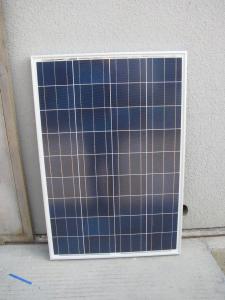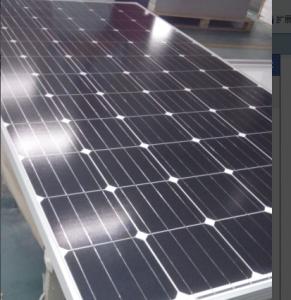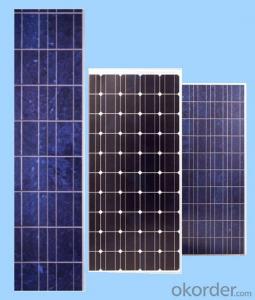Solar Polycrystalline Panel (75W-95W)
- Loading Port:
- Shanghai
- Payment Terms:
- TT
- Min Order Qty:
- 1 pc
- Supply Capability:
- 100000/month pc/month
OKorder Service Pledge
OKorder Financial Service
You Might Also Like
Solar Polycrystalline Panel (75W-90W)
Introduction of Solar Polycrystalline Panel (75W-90W)
High-efficient solar cells ensure high performance and more power under same condition.
3.2mm high-transparent low-iron toughened glass, EVA laminate and water-proof TPT yield long life modules while enhancing cell performance.
Stable, heavy duty anodized aluminum frames with convenient mounting-access, for high wind pressure and snow load.
Bypass diodes to avoid hot-spot effect.
The backside of frames is equipped with drainage holes in order to eliminate the risk that rain or snow water may accumulate in the frame through and freeze or even bend the frame in cold season.
Characteristics of Solar Polycrystalline Panel (75W-90W)
I Solar Cell : High efficiency crystalline solar cell. Even if under the weak light, the solar module can produce maximum power output.
II Tempered glass (toughened glass): Anti-reflecting coating and high transmission rate glass increase the power output and mechanical strength of solar module.
III EVA and TPT: Using high quality EVA and TPT to prevent destroying and water.
IV AI frame: Without screw, corner connection. 6 holes on the frame can be installed easily.
V Junction box: Multi function junction box with water proof.
VI Long lifetime: ≥25 years; Less power decrease.
VII Good performance of preventing from atrocious weather such as wind and hails.
VIII Resisting moisture and etching effectively, not effected by geology.
Standard Test Conditions of Solar Polycrystalline Panel (75W-90W)
The opto-electrical specifications shown below are stabilized values being measured at Standard Test Conditions of multicrystalline silicon Solar Panel, Irradiance: 1000W/m2, Spectrum: AM1.5 at 25°C, The info below is subject to manufacturing tolerances. Where appropriate minutes of measurement are available and are used for the dimensioning of the installation.
Advantages of Solar Polycrystalline Panel (75W-90W)
• CNBM Solar performance guarantees for 25 years
• 2 years guarantee for workmanship for multicrystalline silicon Solar Panel
• Timeliness of delivery
Characteristics of Solar Polycrystalline Panel (75W-90W)
Max Power Voltage Vmp (V) | 17.4V | 17.6V | 17.2V | 17.6V | 18.0V |
Max Power Current Imp (A) | 4.31A | 4.55A | 4.94A | 5.11A | 5.28A |
Open Circuit Voltage Voc (V) | 22.0V | 22.2V | 21.8V | 22.2V | 22.6V |
Short Circuit Current Isc (A) | 4.73A | 4.87A | 5.29A | 5.48A | 5.53A |
Max Power Pm (W) | 75W | 80W | 85W | 90W | 95W |
Temperature Coefficient of Cells
NOCT | 47℃±2℃ |
Temperature Coefficients of Isc (%/℃) | 0.064 |
Temperature Coefficients of Voc (%/℃) | -0.33 |
Temperature Coefficients of Pmp (%/℃) | -0.45 |
Mechanical Data
Power | 75W/80W | 85W/90W/95W |
Dimension | 890×670×30mm | 1020×670×30mm |
Weight | 7.3kg | 8.3kg |
Tolerance | ±3% | ±3% |
The dimension of the modules can be changed according to the demand of clients
Limits of Solar Polycrytalline Panel (75W-90W)
Operating Temperature | –40 °C to +85°C |
Storage Temperature | –40 °C to +85°C |
Max System Voltage | 700V |
Guarantee of Solar Polycrystalline Panel (75W-90W)
Products Guarantee | 2 yrs free from defects in materials and workmanship |
Performance Guarantee | No less than 90% within 10yrs and no less than 80% within 20yrs |
Certificates | IEC, ISO, TUV, CE |
The Producing Equipment of Solar Polycrystalline Panel (75W-90W)
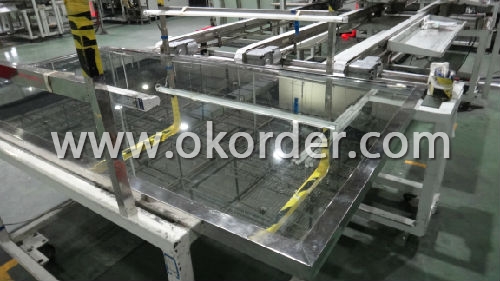
The Production Line of Solar Polycrystalline Panel (75W-90W)
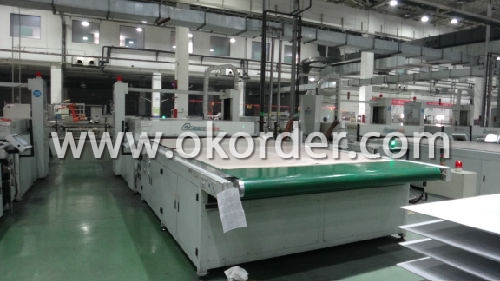
- Q:Can solar panels be used to power a museum?
- Yes, solar panels can be used to power a museum. Solar panels convert sunlight into electricity, which can then be used to power various electrical systems and devices within the museum. The installation of solar panels on the museum's roof or surrounding areas can generate renewable energy, reducing the reliance on traditional energy sources and lowering carbon emissions. Additionally, solar power systems can provide a sustainable and cost-effective solution for powering a museum's lighting, climate control systems, and other electrical needs.
- Q:what is one benifit in a solar panel?
- Solar panels enable use of sunlight for energy. Sunlight is a renewable resource, which means it won't run out, unlike coal and uranium (nuclear energy) and so forth. So there you go! It secures electricity for us for as long as the sun is there... which will be billions of years
- Q:Am using 800watts sukam inverter and have 55watts panel. What controller can i use to connect my solar system to have a max power . Already i have 200 Amp/hr battery
- Guide okorder /
- Q:i wanted to buy solar panels but this guy told me one will just power one light bulb what i want to know is how much thay cost and is it true tat if more power leaves your house than goes in the power company has to send u a cheek
- If you are looking into a credit or buy back of hydro, you should be inquiring about windpower not solar...you will have better luck creating more with that than panels. It is not so much the cost of the panels that is a lot, it is the cost of everything else you will need to use/store the power....inverter, batteries...etc
- Q:Okay so.. if light deflect the light of the sun and black absorbs it, then aren't solar panels just absorbing more light, sun and heat into our atmosphere? Wouldn't this lead to an increase in global warming? Shouldn't solar panals be white? No rude answers please.
- There are two basic types of solar panels. ) Thermal absorbers 2) Photovoltaics Thermal absorbers are black in order to convert sunlight to thermal (heat) energy. The whole idea is to capture all of the light with a dark surface, convert it to thermal energy and transfer the energy into your home for water heating or space heating. If you make the surface white or reflective, then the surface will absorb only a small fraction of the available light, hence the efficiency will be very low. In other words, the panel will not produce any heat. Photovoltaic panels produce electricity instead of heat energy. Photovoltaic panels are made from thin slices (“waffers”) of silicon with special coatings on the front and back surface. One of these coatings on the front is an antireflection coating to capture the light and channel it toward the silicon. Underneath the antireflection coating the silicon waffer is coated with other chemicals that convert the sunlight to electricity. The combination of these coatings gives the panel a dark color, usually blue or black. Here's the bottom line. If you want thermal heat or electricity from solar panels, the panels have to capture the light. When that light is captured, the surface appears dark because no light (or very little) light is reflected back to our eyes. It is not possible for a surface to be an efficient absorber, capturing all available light, and at the same time appear white or bright color or reflective to our eyes.
- Q:I'm curious to know if the small solar panels on a calculator (ie TI-32) could produce a voltage similar to what is used in a single-use (disposable) camera, approximately 4V.
- Build okorder /
- Q:Hello everybody, the area we are living has energy crises with no electricity available most of the time. What I am thinking is to buy a solar panel with other required accessories. Please note we have normally long sunny days most of the time during a year.Please advice installing solar energy system would supply energy 24/7? I have a television, a dvd player, a fan, 4 energy saver lights (2 watt each) and a laptop. Please also advice the specifications for the system to be installed and the points I need to ensure at the time of purchase. I think of buying a solid battery (not acidic battery)The forum is open for your kind suggestions.Thanks!
- We put in photograph voltaic panels before this year, for the final six months we've became on our oil fired boiler approximately seven circumstances, for an hour every time. we are living in north Scotland. Our panels are for water heating only, they comprise fluid which passes by our warm water storage subsequently elevating the temperature. For a 4.4m panel and a greater complicated than regular setup it cost us ?3500 alongside with labour. even nevertheless i've got faith you're thinking approximately panels for producing electricity? wherein case that form of photograph voltaic panel is woefully innefficient in this u . s . a .. i could advise to everybody to in effective condition photograph voltaic panels for water heating, it has stored us a fortune so a procedures and might pay itself back in approximately 5 -0 years depending on oil expenses. For electricity era nevertheless? no longer cautioned. As for grants, as quickly as we utilized we've been informed that all the supply money were used up and that became into that.
- Q:What are the advantages of using solar panels?
- There are several advantages of using solar panels. Firstly, solar panels harness energy from the sun, which is a renewable source of power, making it environmentally friendly. They produce clean energy, reducing greenhouse gas emissions and contributing to a more sustainable future. Solar panels also provide independence from the grid, allowing homeowners to generate their own electricity and potentially save on energy bills. Additionally, solar panels require minimal maintenance, have a long lifespan, and can increase the value of a property.
- Q:i trying to make a solar panel. right now i dont have money to go and buy a copper sheet. so can i make it out of aluminum foil. if there is a way please tell me how. and what do i use for wires. i making this to charge batteries.
- You can't make a solar panel to generate any reasonable amount of electricity from that. You need a semiconductor to start with, in order to have something that can generate free charge carriers(electrons and holes) from photons. Then you need a junction which can separate the charges. In principle you could make a Shottky Diode solar cell from copper if you could find a doped semiconductor to bond a sheet of it to the copper. To form a decent electric field there should be a significant difference in work functions between the copper and the semiconductor, this will generally require the semiconductor to be doped. On top of this you would need a transparent conductor (most used are things like ITO or other 'TCOs' - Transparent Conducting Oxides) to be the top electrode to inject replacement charges into the semiconductor to replace the effect of recombination current. In summary, it's difficult to DIY. You generally need complicated machinery to get decent crystal growth and/or doping.
- Q:Has anyone actually used those kits online like energy4green or earth4energy to build their own solar panels or windmills? I'm so tempted but with my budget can't afford to waste any money. They have a 60 day money back policy but that doesn't include the money used to buy the supplies to try and build the things. My electric bill is almost $300 a month due to my stay at home disabled veteran husband who went from Utah snow to Florida sun and he has to have the AC on really cold. If anyone has actually built one can you tell me of your experience and if it actually is worth the money? I do lots of D.I.Y. projects but am a novice with electric besides installing a ceiling fan and changing out a light switch.
- What I've heard, is that for those sites implying that you can power your house and save money with homemade solar panels, is that if you try to get your money back, there is no response. Maybe if you used a real credit card, you could dispute the charges through your credit card company. Actually, I wouldn't be worried about buying materials and it not working - the more likely scenario is that you would get their instructions, and realize that they're practically worthless. In Florida, you have a chance to save money on your electric long-term, but it will be by investing maybe $0-20k, and then getting that back after 0 or more years. I'd suggest you contact a local solar installer and get a bid, even if it's only to scope out how much it would cost up front. Then you can shop around and see if you could save by installing it yourself. It's a serious project, not to be taken lightly. It took me about 3 months to put it up. It's possible that you will not save money by self-installing, as professionals may get better prices on the panels. The Florida state rebate is subject to availability of funds, and typically, I've heard people wait a long time to get it. The Federal rebate is a credit to your taxes, so you get it the next year.
1. Manufacturer Overview |
|
|---|---|
| Location | Jiangsu, China |
| Year Established | 2004 |
| Annual Output Value | Below US$1 Million |
| Main Markets | Australia;Asia;South East Asia; South America;North America; Europe;Africa |
| Company Certifications | ISO 9001:2008; CE; TUV; UL |
2. Manufacturer Certificates |
|
|---|---|
| a) Certification Name | |
| Range | |
| Reference | |
| Validity Period | |
3. Manufacturer Capability |
|
|---|---|
| a)Trade Capacity | |
| Nearest Port | Shanghai |
| Export Percentage | 1% - 10% |
| No.of Employees in Trade Department | 200-300 People |
| Language Spoken: | English;Chinese |
| b)Factory Information | |
| Factory Size: | Above 8,000 Square meter |
| No. of Production Lines | 6 |
| Contract Manufacturing | OEM Service Offered;Design Service Offered |
| Product Price Range | Average |
Send your message to us
Solar Polycrystalline Panel (75W-95W)
- Loading Port:
- Shanghai
- Payment Terms:
- TT
- Min Order Qty:
- 1 pc
- Supply Capability:
- 100000/month pc/month
OKorder Service Pledge
OKorder Financial Service
Similar products
New products
Hot products
Hot Searches
Related keywords


